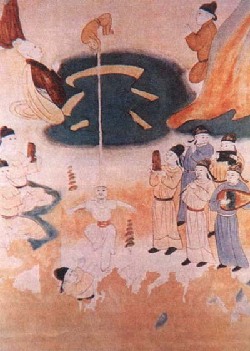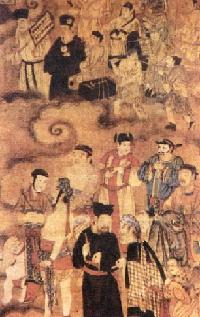The Song Dynasty (960-1279) witnessed a thriving urban economy and the appearance of an influential social stratum consisting of townspeople. Large-scale variety shows like those organized by courts during the Han and Tang periods were rarely seen in the Song Dynasty instead, Waziyuepeng(amusement centers) where acrobats, dancers, martial arts practitioners and balled singers performed together could be found in flourishing cities like Bianliang (today's Kaifeng, Henan Province), the capital of Northern Song, and in Lin'an (today's Hangzhou, Zhejiang Province), the capital of Southern Song. The fact that artists from different professions performed together enabled them to learn from each other and helped shape the unique art form of Chinese opera. A mural dating back to the Song Dynasty found in Dunhuang, Gansu Province, shows an acrobat balancing a long pole on his head while a young boy performed aerial stunts to musical accompaniment.

Pole Balancing with Young Boy Doing Stunts, a Song Dynasty mural in Dunhuang County, Gansu Province
The Yuan Dynasty (1279-1368) was a large unified empire established by the Mongols, one of China's ethnic minorities. The Dynasty ruled China for less than 100 years, but nonetheless had a great influence on cultural exchanges between China's ethnic groups. Zaju, a wonderful form of art and literature in Chinese history, thrived and matured during the Yuan Dynasty. Experts note the name was derived from the combination of acrobatics and poetic drama set to music. The genre can be seen in Yuan and Ming (1368-1644) paintings found in the Baoning Temple in Youyu County, Shanxi Province. The paintings depict Buddhist rituals held to ensure the happiness of people who died on land and in the water. Painting No. 57 entitled Artists and People of Various Religious Sects and Academic Schools in the Pastand painting No. 58 entitled The Souls of Sorcerers Prostitutes, Variety Performers and Court Musicians Who Died Violent Deaths show Yuan and Ming acrobats, magicians and actors performing together Painting No.57 can be divided into two sections. The upper section portrays scholars, peasants and workers, as well as practitioners of medicine, prophecy, astrology and physiognomy. The lower section, on the other hand, shows acrobats and thespians. It is interesting to note that the painting prominently features playwrights and composers.

Acrobatic Artists, a Yuan-Ming period painting depicting Buddhist rituals held to seek happiness for people who died on land and at sea





